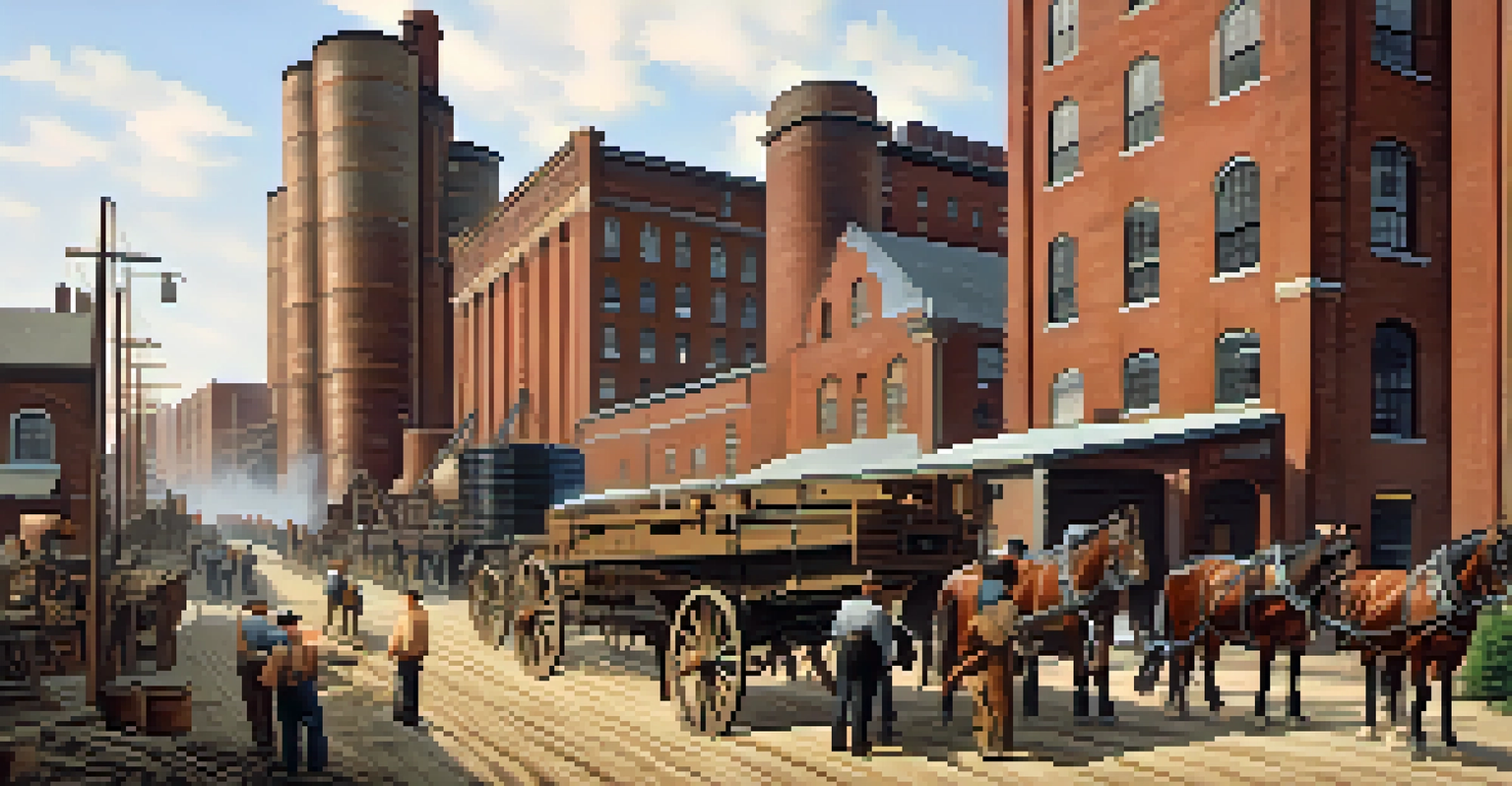Historical Overview of Buffalo's Economic Transformation

The Rise of Buffalo: A 19th Century Industrial Hub
In the 1800s, Buffalo emerged as a bustling industrial center, largely due to its strategic location on Lake Erie and the Erie Canal. This accessibility allowed goods to flow seamlessly between the East Coast and the Midwest, transforming Buffalo into a key trading post. As industries like grain milling and shipbuilding flourished, the city attracted a wave of immigrants seeking job opportunities, injecting vibrancy into its economy and culture.
Buffalo is a city of opportunity, characterized by a diverse economy that encompasses various sectors, including healthcare, education, and technology.
The boom in manufacturing led to a population surge, with residents drawn by the promise of employment in factories and docks. Buffalo became known for its steel mills and auto manufacturing, earning the nickname 'The City of Light' for its early adoption of electricity. This era of prosperity laid the foundation for Buffalo's economic identity, setting the stage for both its triumphs and challenges in the decades to follow.
However, this industrial success came with its own complexities, including labor disputes and social tensions. As Buffalo's population grew, so did the demand for housing and services, presenting both opportunities and challenges. This period marked the beginning of a long, transformative journey for the city, one that would see it navigate the shifting tides of economic fortune.
The Great Depression: Economic Struggles and Resilience
The onset of the Great Depression in the 1930s hit Buffalo hard, as factories closed and unemployment soared. The city, once a beacon of industrial might, faced significant economic challenges, leading to a stark decrease in population as families sought better opportunities elsewhere. Many businesses shuttered their doors, and the economic landscape changed dramatically, leaving a palpable sense of uncertainty in the air.

Despite these hardships, the people of Buffalo exhibited remarkable resilience. Community leaders and organizations banded together to provide relief and support for those affected by the economic downturn. Initiatives like the Works Progress Administration (WPA) helped to employ residents and rehabilitate infrastructure, laying the groundwork for future recovery.
Buffalo's Industrial Boom
In the 1800s, Buffalo became a key industrial hub due to its strategic location, attracting immigrants and fostering economic growth.
This era also sparked innovation as local businesses adapted to the changing economic landscape. From diversifying their product lines to exploring new markets, the entrepreneurial spirit remained alive. The Great Depression was a pivotal moment in Buffalo's history, highlighting the city's ability to endure and adapt to adversity.
Post-War Boom: Rebirth and Economic Expansion
The years following World War II ushered in a period of renewed optimism for Buffalo. The demand for goods and services surged as soldiers returned home and the economy began to recover. Industries such as automobile manufacturing and aerospace thrived, providing ample job opportunities and revitalizing the local economy. Buffalo became a hub for innovation and production, attracting national attention.
The story of Buffalo is not just about economic transformation; it's about the spirit of its people and their unwavering determination to thrive.
During this time, the city underwent significant urban development, with new housing, schools, and infrastructure projects emerging to support the growing population. This boom period not only enhanced the standard of living for many residents but also fostered a sense of pride in the community. Festivals and cultural events flourished, celebrating Buffalo's rich heritage and diverse population.
However, this economic growth was not without its challenges. As industries evolved, some traditional manufacturing jobs began to decline, signaling the start of another transformation. The post-war boom laid the groundwork for Buffalo's next chapter, emphasizing the need for adaptability in an ever-changing economic landscape.
The Decline of Manufacturing: Challenges in the 1980s
The 1980s brought about a significant decline in Buffalo's manufacturing sector, which had long been the backbone of its economy. As companies began to relocate or downsize, the city faced widespread job losses and factory closures. This transition marked a painful chapter in Buffalo's history, leading to an economic downturn that left many residents struggling to find work.
The loss of manufacturing jobs had a ripple effect on the local economy, impacting everything from housing markets to public services. Neighborhoods once bustling with life became ghost towns, as families moved away in search of better opportunities. The city grappled with the realities of a shrinking population and diminished resources, forcing leaders to rethink economic strategies and seek new avenues for growth.
Resilience Through Hardships
Despite facing severe challenges during the Great Depression and the decline of manufacturing in the 1980s, Buffalo's community demonstrated resilience and adaptability.
Despite these challenges, the spirit of Buffalo persevered. Community organizations and local leaders began to focus on revitalization efforts, exploring alternative industries such as healthcare and education. This period of decline ultimately served as a catalyst for reimagining Buffalo's economic future, highlighting the importance of resilience and innovation.
Revitalization Efforts: Turning the Tide in the 1990s
By the 1990s, Buffalo began to see the fruits of revitalization efforts aimed at rejuvenating its economy. Local government, businesses, and community organizations came together to create initiatives focused on attracting new industries and talent. Investments in infrastructure, such as the waterfront and downtown areas, played a crucial role in transforming the city into a more appealing destination for residents and visitors alike.
The emergence of sectors like technology, healthcare, and education provided new job opportunities and helped diversify Buffalo's economy. Educational institutions, such as the University at Buffalo, became key players in fostering innovation and research, contributing to the city's growth. These developments not only attracted new residents but also encouraged those who had left to return, breathing new life into the community.
As Buffalo continued to evolve, its identity shifted from an industrial powerhouse to a city embracing innovation and creativity. This transition showcased the resilience of its residents and their commitment to building a brighter future. The revitalization of Buffalo was not just about economic recovery; it was about reimagining what the city could become.
Current Economic Landscape: A City of Opportunity
Today, Buffalo is a city of opportunity, characterized by a diverse economy that encompasses various sectors, including healthcare, education, and technology. The resurgence of the waterfront has spurred tourism and recreation, attracting both locals and visitors. This transformation has instilled a sense of pride among residents, who are eager to share the story of their city's resilience and reinvention.
The development of startup incubators and innovation hubs has further positioned Buffalo as a growing tech center. Entrepreneurs and small businesses are taking root, contributing to a vibrant ecosystem that fosters creativity and collaboration. This shift reflects a broader trend of cities evolving in response to economic challenges, showcasing Buffalo's adaptability and forward-thinking approach.
A Promising Economic Future
Today, Buffalo is evolving into a city of opportunity, embracing diverse industries like technology and healthcare while focusing on sustainable growth.
However, challenges remain, including addressing income inequality and providing equitable access to opportunities. As Buffalo continues to navigate its economic landscape, the focus remains on fostering inclusivity and ensuring that all residents can benefit from the city's growth. The current economic climate reflects not just a recovery but a commitment to building a sustainable future for Buffalo.
Looking Ahead: Buffalo's Future Economic Prospects
As Buffalo looks to the future, the potential for continued economic growth and innovation is promising. With ongoing investments in infrastructure, education, and technology, the city is poised to attract talent and businesses seeking a supportive environment. The focus on sustainability and smart growth initiatives further enhances Buffalo's appeal as a forward-thinking city ready to embrace change.
Emerging industries, such as renewable energy and advanced manufacturing, offer new pathways for job creation and economic diversification. Collaborations between educational institutions and local businesses are fostering a skilled workforce that is equipped to meet the demands of a changing job market. This proactive approach reflects a commitment to building a resilient economy that can adapt to future challenges.

Ultimately, Buffalo's journey is a testament to the power of community and innovation. As the city continues to evolve, its rich history serves as a foundation for a bright future, one that embraces opportunity while honoring the resilience of its past. The story of Buffalo is not just about economic transformation; it's about the spirit of its people and their unwavering determination to thrive.